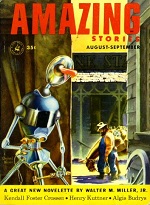Never Go Back
- by Charles V. de Vet
- Short Story
- Science Fiction
- Adults
- Definite Time Travel
- English
- “Never Go Back” by Charles V. de Vet, in Amazing, Aug/Sep 1953.
As his first experiment in time travel, Arthur Meissner visits his own childhood in 1933 with the hope of saving a friend who drowned in the local swimming hole. He seems to aver the friend’s disaster, but he himself no longer exists in 1933, and moreover, he no longer seems to exist even when he returns to his adult time.
By the way, this is another example of a time traveler who arrives naked. I wonder who first penned that now clichéd mode of arrival. Also, the story expresses an early version of the Chronology Protection Principle.
By the way, this is another example of a time traveler who arrives naked. I wonder who first penned that now clichéd mode of arrival. Also, the story expresses an early version of the Chronology Protection Principle.
You see, you yourself are the object in this particular instance, and by going back into time you—the same object—would be occupying two separate units of space at the same time, which is axiomatically impossible. Therefore, nature made its adjustment; the same as it would if an irresible force hit a so-called immovable object. It eliminates one of them.

Variants
(1)
- “Never Go Back” by Charles V. de Vet, in Amazing, Aug/Sep 1953.
